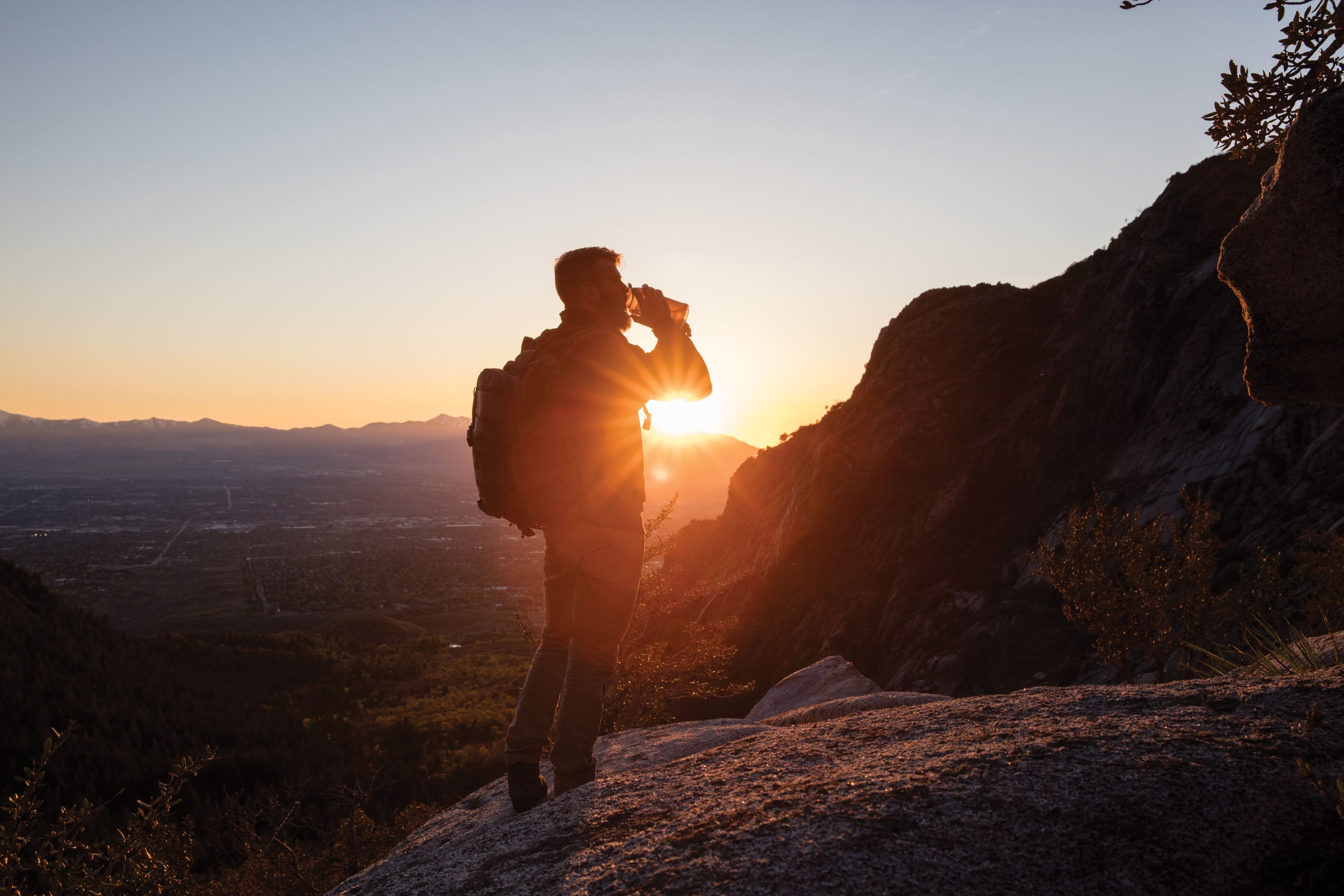
The science behind hydration can be incredibly nuanced, but the takeaway is always the same: proper hydration is important to performance in the field and can mean the difference between an enjoyable experience in the outdoors or suffering through a thirsty endeavor. Here’s everything you should be considering when preparing for your next outing.
The Importance of Hydration
Up to 60 percent of our bodies is made up of water. It assists with all kinds of incredibly important day-to-day functions: delivering oxygen to every corner of the body, regulating temperature through sweating and respiration, forming saliva for digestion, getting rid of waste, and lubricating our joints, to name just a few. The body relies on having enough water to balance our electrolytes, which conduct electricity and allow us to perform basic, automatic tasks like the transmission of nerve impulses and muscle contractions.
According to the National Academies of Sciences, Engineering, and Medicine, adult men need to consume about 3.7 liters of fluid each day, while adult women should be taking in a minimum of about 2.7 liters. About a fifth of those fluids, they say, comes from the foods we eat: most fruits and veggies contain water to help us hydrate us.
There’s good news for coffee drinkers, too. Contrary to popular belief, even your morning cup of java doesn’t dehydrate you—that’s a myth, says the American College of Sports Medicine. The amount of caffeine (a diuretic, which causes you to urinate more frequently) in a cup of coffee is far outweighed by the amount of fluid you’re consuming. Typically, being well hydrated means needing to head to the bathroom every two to four hours.
But don’t put down that glass of water just yet. Good old H2O is still the best way to hydrate. Adding sports drinks is often helpful for high-intensity workouts, but sugary drinks can be tough on the digestive system, especially when you’re dehydrated to begin with. Water is the only fluid your body can use for things like thermoregulation and metabolism, and it also helps with the digestive process.

Signs of Dehydration
Conventional wisdom has it that you shouldn’t rely on thirst to remind you to drink water. If you’re feeling thirsty, you’re already dehydrated. At a cellular level, being dehydrated simply means that more water is leaving the body—first from individual cells, and then from the body altogether, via sweat, urination, or water vapor in exhalations—is being taken in. Since you can’t check in with your individual cells, you’ll need to know some of the telltale signs of dehydration.
That cottony, dry feeling in your mouth is one of the first signs of dehydration, and is often accompanied by bad breath, since the antibacterial properties in saliva can’t keep up when we can’t produce enough spit. You may also notice a headache, and, eventually muscle cramps. Dehydration is also indicated by feelings of confusion or even anger, and if you’re feeling especially fatigued, that’s a good sign you don’t have enough fluid on board.
What’s going on in the bathroom is also a surefire indicator of whether you’re dehydrated. If you can’t remember the last time you had to pee, you’re likely dehydrated. Infrequent urination means you don’t have enough water in your system. When you do go, pay attention to the color and smell. Urine should be light yellow and odorless. If it’s darker in color and has a strong smell to it, you’re overdue for some fluids. This one is especially easy to monitor in the winter, when snow makes it easy to identify the color of your output.

How to Stay Hydrated

Adding Salt
When you’re sweating profusely, you’re losing tons of fluid and salt, which is when experts generally recommend supplementing your water intake with electrolytes or salt. There are tons of electrolyte replacements on the market, so if you’re training for a really big winter outing, consider trying a few different brands to see what works for you before the big day. It’s best to go with what you’re used to when you’re already taxing your body with high mileage, intense output, or many hours out in cold weather, so do some experimentation and take note of what keeps you feeling hydrated. If you do decide to replace electrolytes during exercise, you’ll need to do that every hour or so, whether you’re eating something salty or adding a tablet to your water.
A word of caution with respect to salt tablets: ultrarunners, Ironman competitors, and other athletes who are losing liters of sweat over the course of many hours often use salt packets to stay hydrated, but it’s easy to overdo it. Taking in too much sodium at once can overwhelm your body’s ability to regulate it, and the Center for Disease Control and Prevention recommends limiting daily sodium intake to 1,500 mg per day to avoid high blood pressure for adults over 20 years old.
If you do start to notice signs of dehydration while doing a high-output activity, that’s the time to rehydrate quickly when you’re on the go. Don’t wait until you start to feel like you’re going to bonk. If you’ve got a headache, are feeling sluggish and tired, or your hands are looking puffy, it’s not too late. An electrolyte replacement, whether it’s a tablet in your water, a gel, or fruit chew-type snack, may be enough to do the trick.